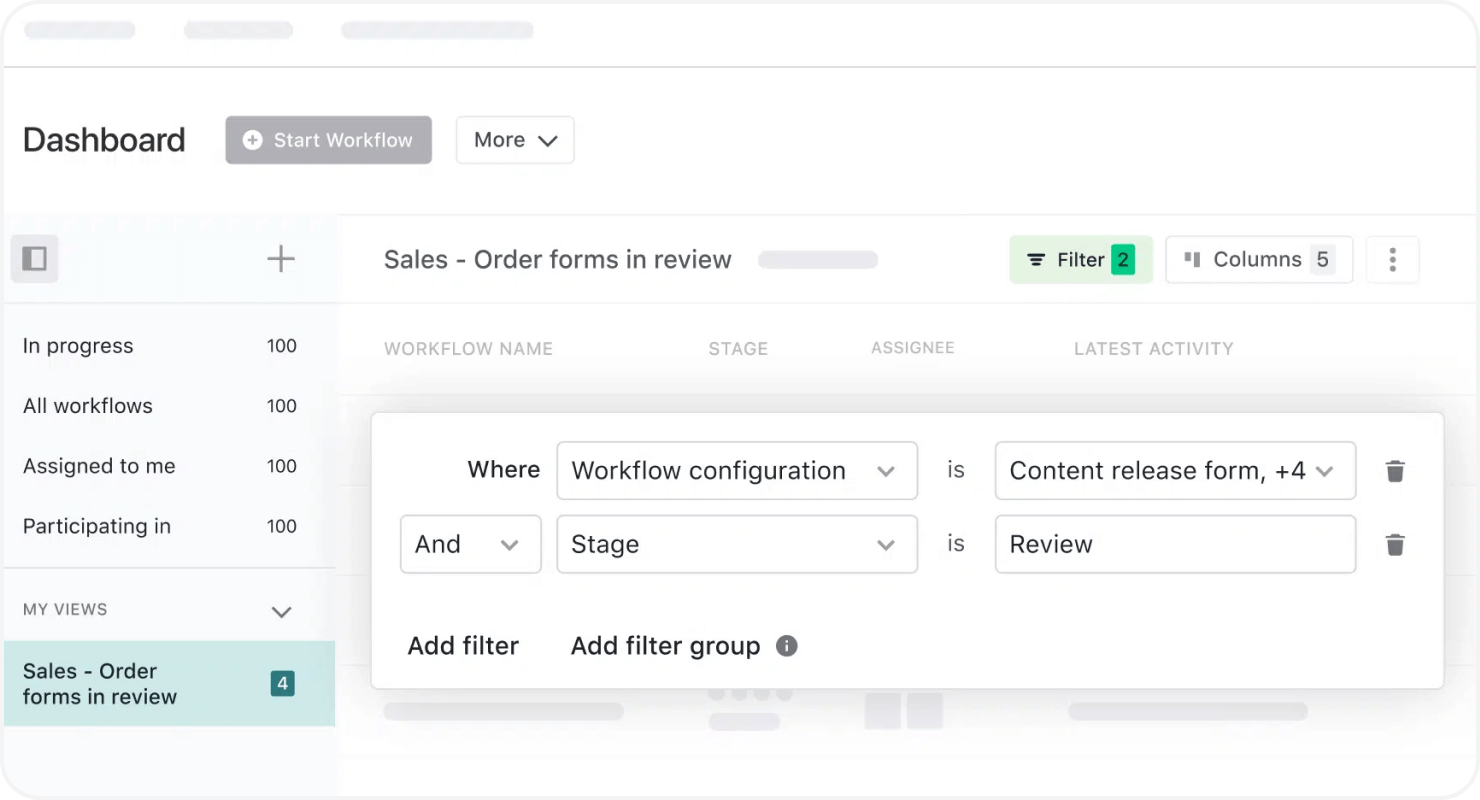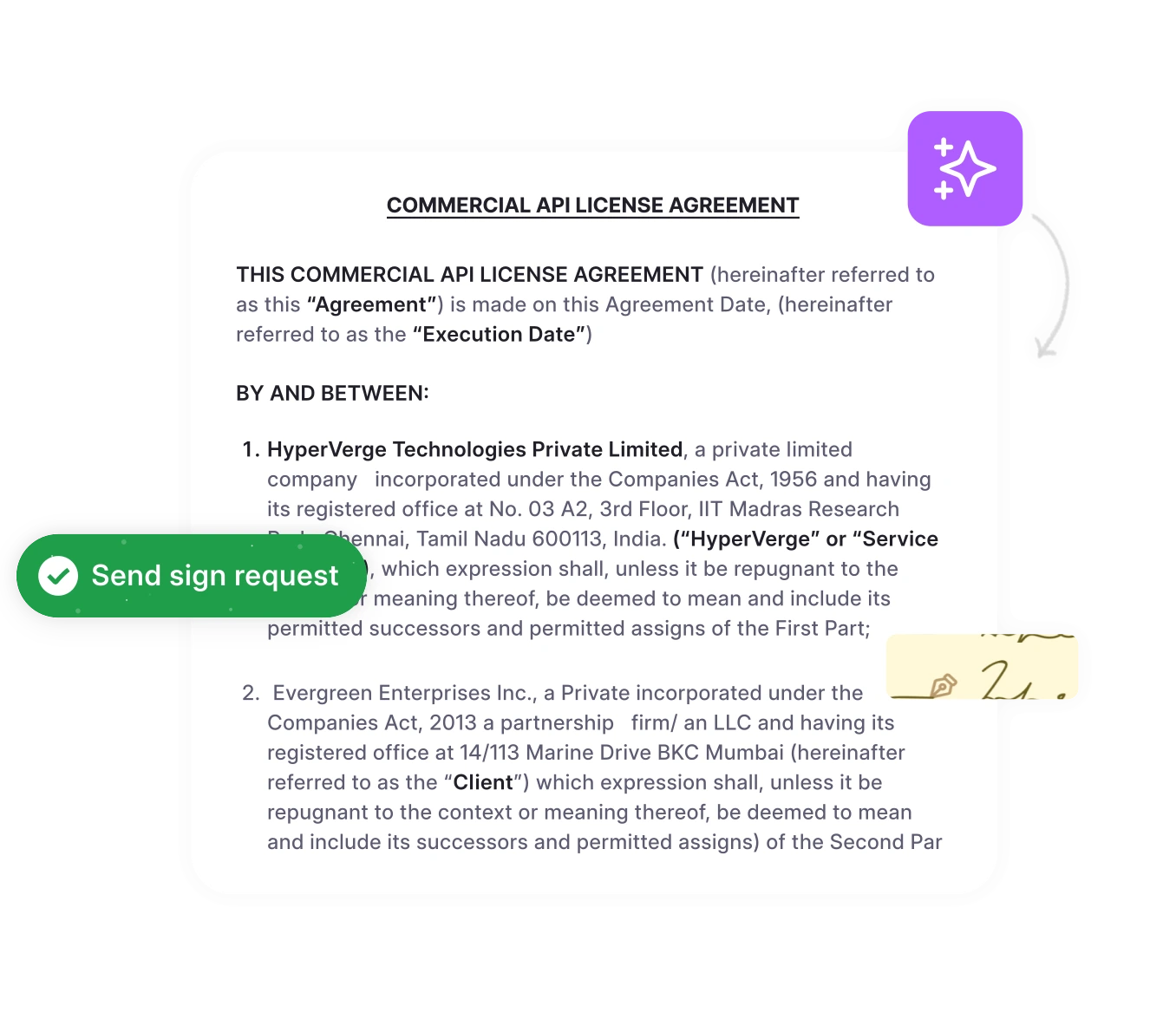Contract approval is a lengthy process that involves numerous departments like operations, legal counsel, finance, and sales. These departments engage in many back-and-forth discussions before they send the contract to the counterparty for signatures.
Approval discussions include giving input on the contract, making edits to key clauses, and fixing drafting errors in bulletproof contracts. Approval can take weeks or, in some cases, even months. Understanding the approval workflow meaning is essential for streamlining this process, as it highlights the stages and responsibilities involved.
A lengthy approval cycle reflects poor contract management, putting the business at risk. A World Commerce and Contracting report shows that poor contract management can cost companies up to 9% of their annual revenue.
However, with a systematic contract approval workflow, this time can be reduced from weeks to a couple of days or even hours. But what is the right agreement approval workflow and how does one get there?
In this blog, we will answer all these questions. Read to understand how a systematic contract approval process can help in effective contract management. Let’s begin.
What is the contract approval workflow?
The contract approval workflow is a process through which contracts are reviewed, revised, approved, forwarded, or rejected. Each department and stakeholder reviews and approves clauses that are under their purview. This structured workflow ensures that a contract passes through the necessary stages before it becomes a binding agreement.
Some of the most common stakeholders/departments involved in the review and approval of contracts are the legal staff, the chief financial officer, the chief operating officer, the senior manager of relevant departments, and the signatories.
Let’s see how this contract process works.
7 Steps in the contract approval process
Each organization has a unique process for approving contracts. However, some basic steps remain the same. Here’s one example of the approval workflow of sales contracts:
1. Contract request is generated by the sales team based on the requirements.
2. The first draft of the contract is passed to relevant departments for review.
3. The contract administrator reviews and approves the contract for accuracy.
4. The legal team reviews the contract and makes amendments for legal precision.
5. The finance department reviews the contract and approves it if it is under the approval amount.
6. The Chief Finance Officer (CFO) reviews the contract for due diligence of finance data.
7. The final signatories/parties to the contract review and sign the contract, pushing it to contract execution.
If a person or a department finds a part of the contract unfit during the approval process, they reject the contract or suggest rectifications. As a result, agreement approval involves a lot of to-and-fro in the entire approval process.
Consequently, the contract approval process takes a lot of time, effort, and communication, especially when done manually. There are many other problems with manual agreement approval which we will discuss in the next section.
4 Common challenges in manual contract approval processes

Manually reading, reviewing, and signing off on contracts is laborious. It not only takes a lot of productive time but also delays closures. Let’s understand more about the challenges of manual contract management.
1. Lacks version control in the contract approval process
Accountability and transparency are essential in contract drafting. While redlining and editing contracts, it is important to keep a tab on changes and follow the workflow waterfalls that make sense for your organization. However, with manual contract review, it is challenging to keep track of contract versions.
Once a department or a person makes changes in the contracts, they are directly implemented in the document. There is no way to track the changes and find out who modified which part of the contract. Moreover, sometimes different departments end up working on two different versions of the same contract, resulting in confusion and potential disputes.
2. Delays in the contract closure timeline
A long approval workflow means that your contract will pass through many stakeholders before it is sent for signing.
Manual reviews of 20-30 page contracts for in-house legal can take anywhere between 4-6 hours. Bogged down with other requests from across the organization, the ratio of legal to sales/other departments is disproportional. This contributes to significant delays in the contract’s execution.
3. Fails to streamline time on contract-related tasks
Spending time reviewing and editing contracts takes away a lot of productive time from different departments. This is especially the case for businesses that deal with a large volume of contracts on a day-to-day basis.
In the end, manual agreement or approval means that departments must spend more time on contractual work and less time on their personal and professional lives or strategic work.
4. Faces difficulties in the contract review process
Manual contract review is prone to human errors and negligence, especially when reviewers are dealing with high volumes of contracts. However, in many critical contracts, minor negligence can turn out to be a costly mistake for your organization.
Additionally, contract review workflow may result in improper negotiation and legal negligence. A minor oversight can lead to missed negotiation opportunities, renewals, or deadlines.
Many organizations face these problems with a manual contract approval process. The solution to these challenges is to find the balance between efficiency and a thorough review. Approval workflow automation is one way to achieve this objective.
Tip: A World Commerce and Contracting report states that 40% of organizations don’t have clear contract responsibilities. Shifting from manual to automated contract approval workflow helps define contract-related responsibilities and moves contracts faster.
Let’s take a look at the benefits of automating agreement approval workflow.
5 Benefits of automating contract approval workflow

Automation helps streamline contract approvals and get to a yes faster. Thanks to the availability of intelligent contract automation software like HyperStart CLM, you can automate contract approval processes while also ensuring accurate reviewing and redlining. Here’s how:
1. Get real-time contract approval status
Automated contract management workflows help streamline internal approvals with easy no-code setup. This saves up to 70% time on contract admin and accelerates contract turnaround time 5x. You can also track who has the pen at each contracting step and prompt stakeholders with automated reminders for faster closures.
2. Speed-up contract reviewing and redlining
HyperStart CLM offers AI-redlining to generate a first draft of the contract in less than a minute, saving about 50-60% of legal review time. Legal resources can be employed better for higher-order work without the opportunity cost.
3. Increase contract visibility
Contracting process metrics like contract status, number of turns, and review time help optimize the efficiency of your contract management lifecycle.
The in-flight dashboard of the approval process collects this data to identify bottlenecks to help you streamline your business processes.
4. Elevate contract accountability
Contract approval workflow automation has handy functionalities like audit trails, comments, and version control. This is a secure and fail-proof way to gain better visibility and control of your contracts with accountability.
5. Enable legal teams to self-serve contracts
Today, many CLM software solutions enable businesses to self-serve contracts. The contract initiator can easily set up a contract using a pre-approved clause library or repeatable standard-form templates, empowering other teams to draft contracts without legal dependencies.
Additionally, self-serving contracts work with drag-and-drop functionality. This way, your teams can create new contracts within minutes. No more writing contracts from scratch.
These were the top benefits of automating the contract approval workflow. Now, let’s learn about these best practices for managing contract approval workflow.
Ready to Agree Contracts Faster?
Get an end-to-end CLM solution to manage contract approvals. Agree to contracts 10x faster with HyperStart.
Top 5 software to automate contract approval workflows

Here, we have listed some of the top CLM tools offering contract workflow automation functionality. We have selected these tools based on factors like:
Workflow automation capabilities
G2 and Capterra reviews and ratings
User opinions
Let’s take a look at the top workflow automation software options.
1. HyperStart CLM
HyperStart CLM offers an end-to-end contract lifecycle management platform. Powered by HyperVerge AI, the solution powers all stages of your contract lifecycle process, including the contract approval workflow.
HyperStart CLM’s built-in contract workflow approval software helps you build no-code workflows for your approval process. With HyperStart CLM, you can accelerate contract approval, reduce contract turnaround time (TAT), and minimize business risks—all of this automatically.
Additionally, HyperStart CLM is also ideal for managing a service contract approval workflow, ensuring that service agreements are properly reviewed and approved by the relevant departments before final execution.
HyperStart CLM’s workflow builder system helps you view all your in-flight contracts, get detailed activity logs, and track contract action items centrally. Today, HyperStart CLM is used by top brands like Khatabook and LeadSquared for its efficiency in contract workflow management.
Key features of HyperStart CLM’s workflow builder:
No-code contract approval workflow builder for business-specific processes
Automated email reminders and notifications for faster approval
Centralized in-flight dashboard for ongoing contracts
Conditional approvals with an option to add ad-hoc approvers
Secure audit trail to track all changes in the contacts
Highlights of HyperStart CLM’s contract approval workflow builder:
70%
Less contract admin time
5x
Faster contract turnaround
80%
Less contract admin time
Streamline Contract Approvals With HyperStart CLM
Smarter, faster, and smoother approvals. Get to a yes faster. Only with HyperStart CLM.
2. Juro

Another popular CLM offering contract approval workflow builder functionality is Juro. This contract management software is excellent for getting your contracts approved and signed faster. With Juro’s contract approval workflow builder, you can set granular controls and get a real-time view of approval status, hence promoting CLM efficiency and contract visibility.
Key features of Juro’s workflow builder:
Template-level approvals to ensure contract security
Internal commenting and suggestions for faster redlining
Unique visual timeline to track all contract changes
3. Ironclad

Ironclad offers a simple workflow designer that helps you build and launch contract approval processes within minutes. Ironclad’s drag-and-drop workflow-building tool comes with AI-based playbooks to help you standardize contracts for consistency. This ensures that you create a compliant contract that gets approved faster.
Key features of Ironclad’s workflow builder:
Launch contracts faster through Salesforce and Slack integrations
Route contracts to the right approvers
Add approvers, signers, and conditional rules for contract clauses
4. Concord

If efficiency and legal compliance are your key objectives for your contract approval workflow, Concord is another great tool you should consider. This contract management software offers a contract approval workflow builder to help you stay in control of your contract and save time. With Concord, you can standardize contracts for faster redlining, negotiation, and approval.
Key features of Concord’s workflow builder:
Create a pre-defined contract approval workflow library to directly add to your contract
Create conditional approval steps based on smart fields
Automatically notify the next approver in line via email and in-app notifications
5. SpotDraft

SpotDraft is another contract lifecycle management software that offers excellent functionality for contract workflow automation. With SpotDraft, you can put your contract approval workflow on autopilot and also ensure great efficiency and speed in the approval process.
Key features of SpotDraft’s workflow builder:
Mandate approvals from relevant stakeholders based on contract value
Assign review requests to team leads
Sign contracts with a low-risk factor for speedy approval
These are some tools you can use to automate your contract lifecycle, including contract approval. Use any of these tools to streamline your contract approval workflow and accelerate your redlining process.
Contract workflow automation tools, in combination with some best practices, ensure smooth workflow operations. Keep reading to learn about these best practices.
Best practices in contract approval workflow management
1. Redline and review with AI
AI-redlining saves up to 40% of contract review time. The AI technology automatically reviews the contracts and sends them for signing. Faulty clauses are flagged and highlighted if any are present in the contract. This allows you to spend more time on high-complexity contracts and use automation for low-complexity ones.
2. Granular controls
Examine your organization’s unique contract lifecycle management process before you streamline your workflows. Identify the key challenges in your workflow process across contract types like MSAs, NDAs, SLAs, etc. Identify key pain points that are unique to your organization and existing tech stack. Custom, personalized workflows with granular controls help you curate the user experience while maintaining the highest degree of compliance, due diligence, and security.
3. Create with pre-approved clauses, conditions, and templates
Contract workflow management systems offer other pre-execution functionalities to make the contract creation process faster. Legal-approved conditional rules, clauses, and standard-form templates slash contracting costs by up to 33%. This ensures efficiency, accuracy, and compliance without legal dependency.
These were some best practices to help you leverage contract approval workflow tools and speed up the approval process. To ensure that all necessary steps are covered in your contract management, using a contract approval workflow checklist can help streamline the process and improve compliance. By now, you have all the information needed to optimize your organization’s agreement approval workflow.
Looking for a smart contract approval workflow automation solution?
Contract approval processes can be laden with bottlenecks if not managed properly. A streamlined contract approval workflow ensures your contract runs smoothly throughout the review process without delayed closures.
One of the best ways to streamline your approval process workflow is to use automation.Automated contract approval workflow tools help reduce manual approval work and set up frictionless workflows for contracts. Choosing the right contract approval software for your organization is key.
HyperStart CLM offers AI-powered contract workflow automation software to help you boost contract negotiation, redlining, approval, and signing. To see how HyperStart can streamline your contract approval process, check out this video walkthrough of the platform in action.
With HyperStart’s advanced technology, get an effortless, fast, and secure contract management experience. Here are some benefits of contract approval when using HyperStart CLM.
- Get 5x faster turnaround time for contract approvals.
- Reduce contract approval time with automated reminders and notifications.
- Track pending contract approvals in one secure location.
Today, HyperStart CLM is used by top brands like Khatabook, LeadSquared, and Qapita for its efficiency in contract workflow management. Here is one of the testimonials from the legal head of LeadSquared.
We took demos of around 5 CLM vendors and chose to use HyperStart. They were the only CLM vendor who had SOC2 compliance and met the criteria of around 22 parameters which we had evaluated them on.

Om Prakash Pandey
Head of Legal at LeadSquared
Having such a solution allows you to focus on strategic legal aspects while managing risks. If you are looking to transform your contract approval process, contact our team today to get a demo of our contract workflow automation software.
Speed Up Your Contract Approval Process
Accelerate approvals and save 70% on turnaround times with HyperStart CLM’s automated workflows.












